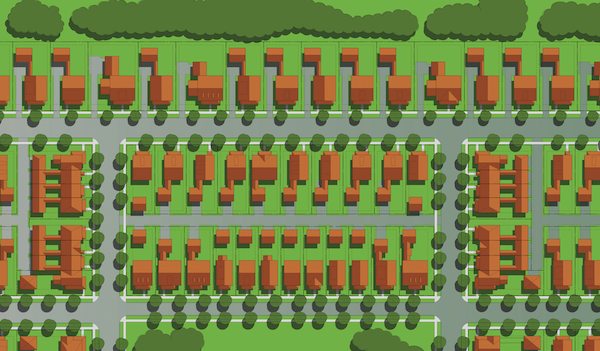Whether you’re a builder or developer, you know that the real estate game has changed a lot since 2008. All parties involved in construction have become more cautious, in an effort to build exactly the right product. Lenders are wary of development deals that stray from the so-called proper financing formula. Builders balk at variations on known housing types. Buyers seek housing options that represent the best value per square foot. The “build it and they will come” mantra doesn’t apply anymore.
Today’s neighborhoods and the homes you build in them need to reflect long-term, lasting value while maintaining all the aspects of a great community. Looking back over the past decade, we can see that the communities that sold well did so because they offered a true sense of place. Those neighborhoods share common qualities: diverse housing types, varied lot sizes, usable open space, and the ability to accommodate many different stages of life.
Planning is key, but the homes themselves are just as crucial for that good result. Here’s how you, as a builder, can build homes that sell well and result in communities that become great places to live for decades to come.
Varied Product Attracts More Buyers
Most new subdivisions built today are segregated by price. Owners of a $500,000 single-family home don’t want to be next to a $300,000 townhouse, just as the owners of a $1.2 million single-family house don’t want to have a $500,000 home next door. We put gates around the communities to keep out buyers of dissimilar product.
But providing an integrated range of options and choices for buyers remains crucial for good sales and continued financial health. Think of the empty nesters who love the neighborhood they’ve been in for 30 years but can’t find a small, one-story house to age into. Consider the young couple that started out in a townhouse but now needs another bedroom and a yard for the kids to play in, and doesn’t want to move to another town.
Some of the best neighborhoods offer an integrated range of product. I live in Baltimore in a pre-World War II community with townhouses, duplexes, triplexes, small houses, and large houses, all gracefully integrated. From my front porch, I can throw a stone in one direction and hit a $300,000-plus townhouse, or in the other direction, a $2 million single-family home—all within a block of each other. The neighborhood works because variety, options, and lifestyle choices attract a greater range of potential buyers than a singular housing option of just one product type and price point. Well-designed neighborhoods established prior to World War II maintained greater value during the recession partly due to their maturity, but principally because they adapted to various lifestyles and stages of life better than conventional single-family developments by being relatively close to shopping and services and by being walkable.
Diverse Product Adds Value
This isn’t social engineering; it’s about higher real estate value. If you own a house in a subdivision where the houses are all one type, value can only rise and fall based on the demand for that singular housing type. But when there are a multitude of choices available from a smaller pool of overall inventory, prices are set by the demand for the neighborhood.
Find your niche. You can earn a profit and best your competitors by working within master planned communities to build niche products. Rather than going head-to-head with the competition on the same basic house type, become the expert in a different product market such as higher density single-family or attached single-family housing.
Offer a range of home types. Yes, the banks like comps because they’re a sure thing, a familiar thing, and a comfortable thing. But banks also like value. Newer communities such as I’On, in Mount Pleasant, S.C., and Celebration, near Orlando, Fla., are commanding selling prices that are between 17 to 26 percent higher than communities right next door. That’s because they offer greater options to accommodate various life stages, including apartments, townhouses, and small-lot single family and large-lot single family homes, all within the same community. Buyers have options to fit their situation and choices to fit their budget. Each of those puzzle pieces has a value that creates a lasting whole and a finished work.
The House Must Suit the Lot
Focusing on curb appeal should be a builder’s primary objective: Respond to each lot with the appropriate floor plan and architecture. A corner site with high prominence in the neighborhood that sits across the street from a public park deserves a large wraparound porch on the corner to maximize views and orientation to the park (rather than a three-car garage set on that corner). Driveway and garage locations need to be set in secondary positions so that the prime spots on the lot get the most play. If a site has prominence, you can play it up with special touches such as a third-floor tower to offer views to the open space. Everything should add to the special location.
Understanding the specialness of each lot is how you can outdo the competition. Rather than building stock homes on any lot, include houses in your portfolio that can make the most of unique lot conditions. Design your floor plans to orient toward special areas or views within a master plan. Build elevations that capitalize on good views with large, usable porches, and charge a premium for it.
Graded Lots Differentiate Offerings
The best neighborhoods have varied lots. Some within a master plan have greater value because they’re located on higher sites, have great views, and are close to parks or common open space. These lots should receive an “A” grade.
If the developer hasn’t already done so, consider grading lots according to their value within the master plan. A lot with a midblock location may be an average lot within the development. It’s typical and should meet all of the requirements of the design criteria related to setbacks, architectural aesthetics, garage location, and associated fundamentals of being a good house within the neighborhood (“C” grade).
A lot of similar size within the same general area of the master plan may have some conditions that make it slightly more desirable, such as a view to a park, a bend in the road, or placement near a stand of existing mature trees (“B” grade). The home built on it should respond accordingly. If the lot is located at a bend in the road and the front door is oriented toward a view to a park farther up the street, capitalize on it. Orient interior spaces toward the view and add value with a generous front porch. In turn, you should recoup the added value through a higher price.
Build for Both Open Space and Privacy
Municipalities are struggling with overcrowded roads, insufficient services, not enough affordable housing options, and a lack of capacity for aging in place. These are all reasons why creating neighborhoods that offer varied housing options, plus services and walkability, makes sense. Increasingly, cities and towns are opting for these types of developments. More and more, developments are including well-integrated open space to relieve the increase in density.
Green spaces help integrate houses. Public green spaces also create places where people love to live, and thus, add value. A mews or commons that’s a green space and walkway immediately at the front door of a house demands a home that enhances the enjoyment of living on a park. Respond by raising front porches above grade a minimum of 18 inches and setting vehicular access at the rear of the lot. Here, lots can be smaller because the outdoor space is the park in the front. On the lot itself, the house can be arranged to maximize the orientation toward the park, yet the floor plan can be shaped to form a private outdoor courtyard space.
Closely spaced homes on small lots need privacy. On narrower lots, design plans so that one side is more open, with additional windows, while the other is more private. The open side of the house would be the private yard space, and the house plan should become L-shaped or C-shaped to enclose an outdoor private courtyard with as many rooms and spaces opening to it as possible. The private side wall of the house should limit windows that look across at neighbors by locating service spaces along that wall, with higher window sills to eliminate visibility either in or out from adjoining properties. When done properly, houses like these add greater density without the negative perception of high density.
When you’re working in a master planned community, there are a lot of rules to follow. In addition to setbacks, lot coverage, height restrictions, and building codes, there are the unwritten rules of making each house be a good neighbor, affording privacy and adding value to the whole. Each dwelling becomes another puzzle piece to be added to the overall community. How all the parts work together determines the ultimate success or failure of any new development. If you understand the inherent value of each lot and design housing types and products that suit it well, you’ll be the competition, and you’ll enjoy tremendous success.

Getting Density Right
Integrating multiple housing types and greater density into a real neighborhood requires rethinking the conventional suburban development.
Fit housing types together, like puzzle pieces. Avoid jarring juxtapositions with abrupt scale changes. All the housing types within a neighborhood should be of the predominant scale and proportion of the majority of structures. A series of small one- and two-story cottages immediately adjacent to three-story townhouses is an abrupt and jarring juxtaposition. Instead, gradually transition between building types for a natural and logical progression toward greater height and density.
Use corners wisely. Fit townhouses into single-family streetscapes by allowing the end unit of a row of townhomes to take on the scale and character of the adjacent single-family houses. The fact that the end unit is not a detached single-family home won’t be apparent until viewed from around the corner. Making product changes around corners, behind alleys, and across parks and open spaces (instead of across the street or adjacent) will help integrate various housing types.
Leverage green spaces—even tiny ones. They’re great ways to integrate a variety of product offerings in close proximity to one another. Plus, the open space offers relief to higher density while using that density to frame spaces or create edges. Small neighborhood parks can be lined with a row of townhouses to form a backdrop, while small homes around a streetless mews, as described earlier, is a great way to develop affordable housing on small lots suitable for young families.
Offer smart parking solutions. To make dense streets more pedestrian friendly, set parking behind the house, either by recessing the garage or providing garage access via service alleys in the rear. A garage that sits a full 20 feet behind the main body of the front wall of the house shields a car from view if it’s parked in front of the garage on the driveway apron. The driveway apron can be the full width of the garage, but it should taper to a width of 10 to 12 feet when it reaches the sidewalk. Suddenly the character of the street changes to being about the people who live there rather than about the cars that are parked there.
Scale down garage doors. They need to be scaled to fit the residential character of a true neighborhood. Two single garage doors work better visually along a streetscape; but they’re not always practical due to vehicular maneuvering and space requirements. Some manufacturers of two-car garage doors of 16-foot or 18-foot widths offer designs that give the appearance of two carriage doors within a single, wide opening. These are a better aesthetic solution when faced with the need for a single, large opening.
Architect and urban planner Michael Medick is Land Planning Market Leader for BSB Design. Write him at mmedick@bsbdesign.com.
Advertisement
Related Stories
Sales + Marketing
New-Home Sales and Navigating the 3 D’s: Death, Divorce, and Downsizing
Here’s how home sales experts manage challenging lifestyle changes with and for their buyers
Housing Policy + Finance
Even With Inflation Running Hot and Elevated Mortgage Rates, Buyer Demand Rises
Mortgage rates will likely stay high for the next few months, but that doesn't seem to be deterring homebuyers
Market Data + Trends
A Look at Homeownership Rates Across the Nation
Data for homeownership rates in the 100 largest US cities show Port St. Lucie, Fla., in the top spot, while West Virginia is the state with the most homeowners







